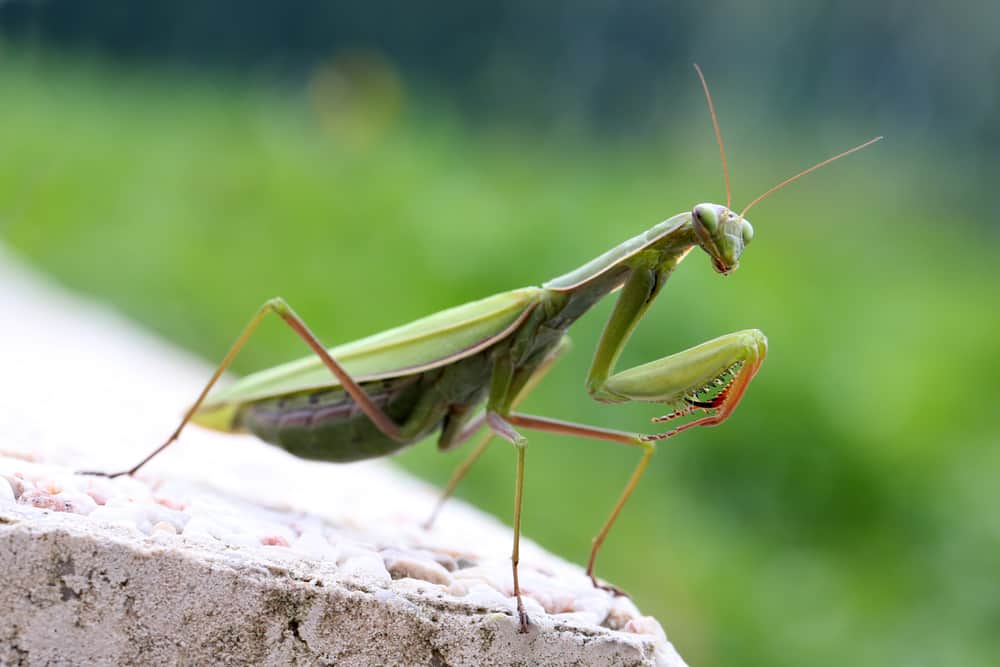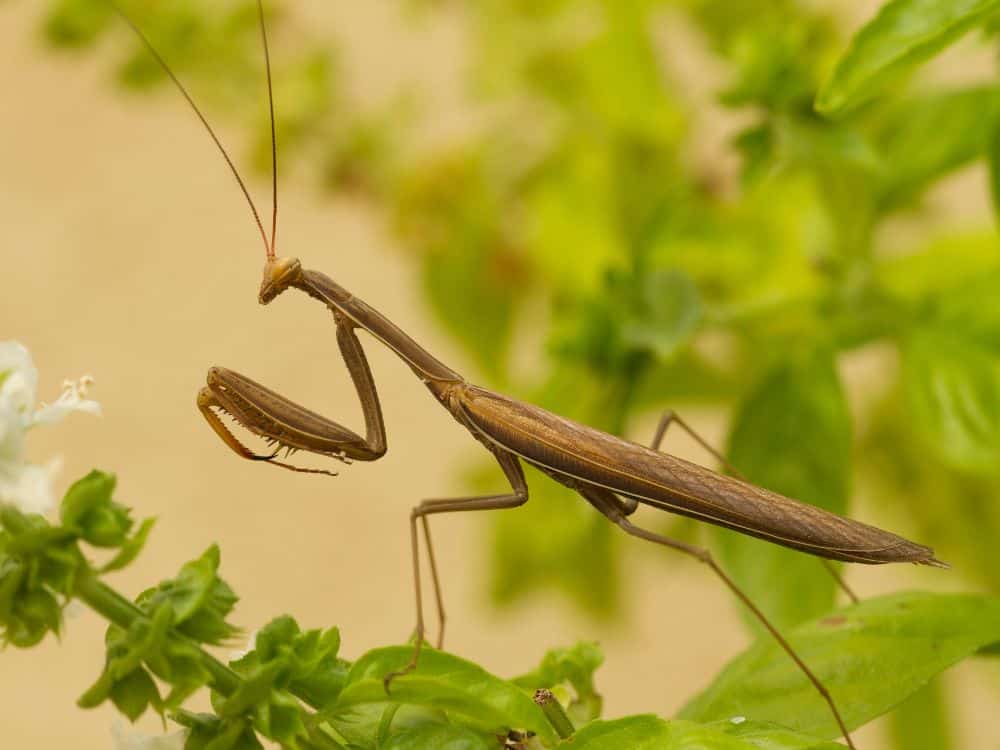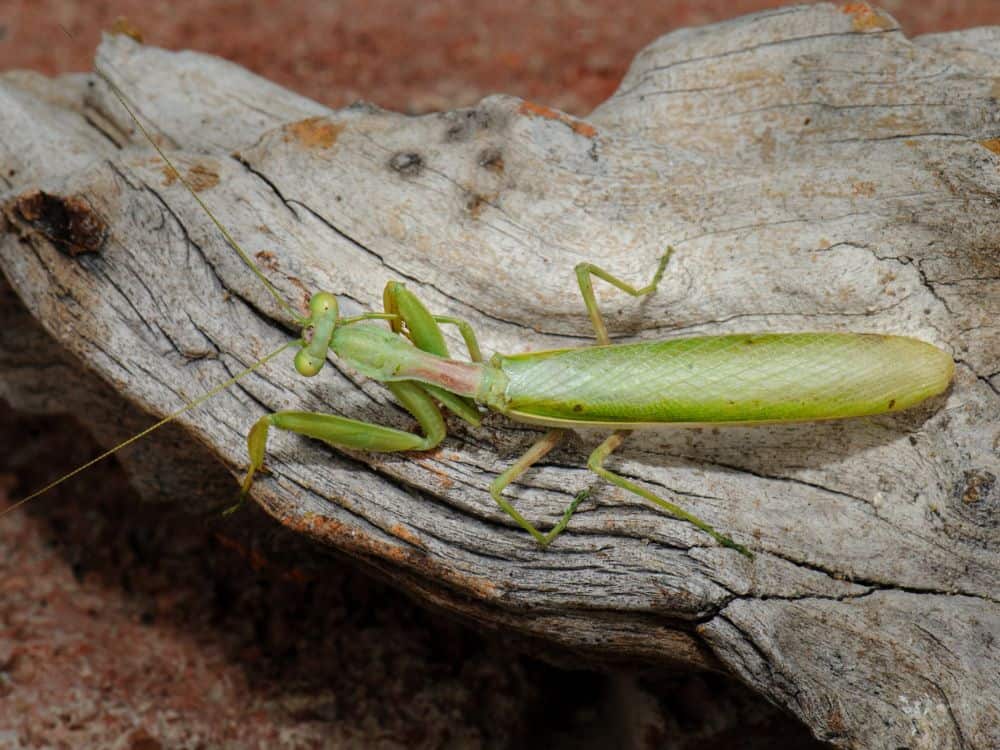Praying mantises are fierce creatures, but they don’t live very long. Most only live a single season, giving them enough time to hatch, grow, and eventually reproduce.
Their natural lifespan is determined by species and size. Most larger mantises live longer, some as long as 2 years, while smaller species like the bolbe pygmaea (Australia) only make it for 3 or 4 months.
We will explore the different factors that influence praying mantis lifespan in this article, as well as their stages of development and things that can cut this short.
Factors that Affect Praying Mantis Life Expectancy
There are about 1,800 different species of praying mantises worldwide. While their average lifespan is around a year, there are far too many varieties to mean this is the norm.
The natural expected lifespan for praying mantises is determined by:
- Whether they are wild or captive
- Gender
- Size
- Species
These factors ignore external conditions and untimely death.
Wild vs Captive
Like most insects and animals, captive praying mantises live longer lives than their wild relatives.
While most wild mantises only make it 6 to 12 months, the average lifespan of a pet praying mantis sits at 12.6 years. They more consistently reach the end of their lifespan because of the lack of predators and more consistent care.
This doesn’t mean that pet praying mantises will always live this long. They’re still constrained by other details, such as species, and may still get sick or have an untimely death.
Pet praying mantises benefit from caretakers who acknowledge their unique needs and pay attention to their current condition.
How to Maximize Captive Mantis Lifespan
- Set up proper housing, including appropriate size, substrate, climbing and hanging surfaces, and proper ventilation.
- Pay attention to humidity and temperature as these differ depending on species. Moisture may be anywhere from 30 to 80 percent, while the temperature is anywhere from 62.6°F to 104°F.
- Provide proper nutrition on an appropriate schedule, focusing on high-quality live insects from a reputable source (and keeping in mind that many mantises do not eat daily)
Gender
Regardless of species, female praying mantises tend to live longer than their male counterparts. This likely has to do with their unique cannibalistic mating practices.
This Journal of Entomology and Zoology Studies research on the mating and cannibalism habits of the Mantis religiosa noted that females lived an average of 196 days, while males lived 165 days.
When praying mantises mate, the female usually eats the head of the male to reduce his sex drive while they are in the act. After they are done, the female will eat the rest of the body.
She follows soon after, living long enough to lay eggs and continue the cycle of life.
Size and/or Species
You may hear that praying mantises last a single season, but this “season” can last anywhere from a few months to a couple of years.
Most larger mantises live 12 months or longer. This includes:
- Giant Asian Mantis
- Chinese Mantis
- Devil’s Flower Mantis
- Wandering Violin Mantis
- Giant Rainforest/Australian Mantis
Smaller mantises, like the Orchid Flower Mantis, only life up to 6 months.
The Praying Mantis Life Cycle
The praying mantis life cycle involved 4 stages:
- Egg (while in the mother’s egg case until they hatch)
- Nymph (from hatching until they molt six times)
- Adolescence (after the sixth molt until they become full adults)
- Adulthood
Each stage is marked by certain characteristics, and you can further break them down into “instars” or phases before, between, or after molting. Praying mantises shed their exoskeleton a total of 7 times before they become an adult, growing bigger each time.
Egg (Ootheca)
Many (not all) praying mantis females lay their eggs in autumn right before it gets cold, and the eggs incubate for about 10 weeks before hatching in the spring.
A female lays anywhere from 100 to 400 eggs, but they’re not always fertilized. Some females do this even if they do not mate. She can also lay multiple ootheca in different locations.
She finds a sturdy structure to house the eggs while they wait to hatch, using a tree branch or a plant’s stem to camouflage the brown egg case. They will be protected here until they hatch and become nymphs.
Nymph (1st Instar to 6th Instar)
From the time they hatch to their 6th molt the praying mantises are nymphs.
When they are smaller they stick close to the egg casing, and they will probably eat a few of their brothers and sisters before they get big and brave enough to branch out.
Eventually, the praying mantis nymphs begin to hunt for larger prey. They may start with small insects like fruit flies before moving onto crickets, grasshoppers, moths, and other pests.
While they are nymphs the praying mantises go through stages of growth during which they shed their exoskeleton. Each of these stages are referred to with an L-level (i.e. L-1 to L-6).
Molting is a sensitive time for praying mantises, and they’re more susceptible to become prey at this time. They won’t eat much beforehand, and the molting process slows them, making them a sitting target for frogs, larger spiders, lizards, bats, and birds.
Adolescent (7th Instar)
At the L-7 stage praying mantises are considered adolescents or sub-adults. They’re significantly larger than nymphs, and most species reach this point around 120 days after hatching.
This is an in-between stage when they’re too large to be babies and too underdeveloped to be adults. Adolescent praying mantis live because of their size, but they still lack the skills, weapons, and wings of an adult mantis.
Adolescence usually occurs from the middle to the end of summer.
Adult
Praying mantises are adults after they finish their seventh (and final) molt. If they are a species that has wings, they will emerge with them at this time.
Adult females develop a heavier abdomen that helps distinguish them from adult males, and some species have noticeable differences in mantis size depending on gender.
Adults can be anywhere from 1 to 6+ inches long (depending on species). They use their lifetime of experience to hunt down larger prey, including:
- Larger insects
- Mice
- Lizards
- Frogs
- Small fish
Some have even gone after small nesting birds.
Adulthood doesn’t last long compared to other creatures, and praying mantises may only live a few months longer at this point.
Reasons for Praying Mantis Death
The most common reasons that praying mantises die include:
- Predation
- Cannibalism
- Environmental factors
These are what prevent praying mantises from completing their expected lifespan.
Predation
Praying mantises are effective fighters and predators, but this only does so much to protect them from the circle of life.
While many insects avoid praying mantises, larger spiders like tarantulas and giant hornets can hold their own against the scythes and skills. Birds and bats may also snatch them up.
While those larger than 6 inches are pretty much left alone on ground, smaller species are attractive prey for larger lizards, snakes, frogs, and scorpions. They usually still avoid them because of their spiny forelegs and aggressive nature.
Humans also play their part in the untimely death of praying mantises. Some may kill them out of a general fear of insects, but the more common scenario involves pesticide use that mantises have no defense against.
In many cases, the pesticides are so effective they knock out all the mantises in an area, opening the space for pests to move in.
Cannibalism
Cannibalism is a way of life for mantids, and it starts at birth. Nymphs often turn on each other if no other prey is available.
The bizarre behavior is common enough that most know that males don’t make it out of mating alive. Sexual cannibalism usually involves a female attacking the male, but modern research has noticed that male mantises are not innocent.
They may attack first, which scientists believe is an attempt to encourage mating. Females will usually cannibalize any males that lose this fight, but males who survive often move onto mating.
Environmental Factors
Praying mantises are pretty hardy insects, and they can usually survive drought or a lack of available food in the wild. Captive mantises are the ones more likely to die from environmental factors outside of the norm.
This includes improper diet, and many nymphs can starve if their caretaker doesn’t realize they aren’t catching their food. Furthermore, the nymphs will likely drown if provided a body of water (which they don’t need).
Improper temperature and humidity levels can interfere with molting and general health, causing damage to the mantis or opening the door for illness that eventually kills them off.
Conclusion
Mantises may live anywhere from 4 months to 2 years. To get a clear idea of how long the mantis in question may live, you should consider its species and gender as well as whether it’s braving the wild or growing up in the comforts of a controlled environment.
Praying mantises don’t live for long, but they make the most out of the time they have. From the moment they hatch they’re on a life mission to become nature’s hitmen, and they can only hope to make it to adulthood to fully live out this dream.
If you have further questions regarding praying mantis life spans or behaviors, leave them in the comments!


